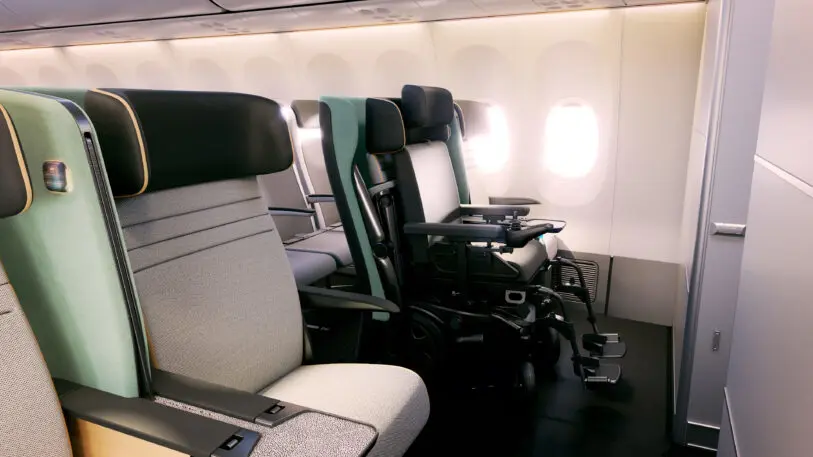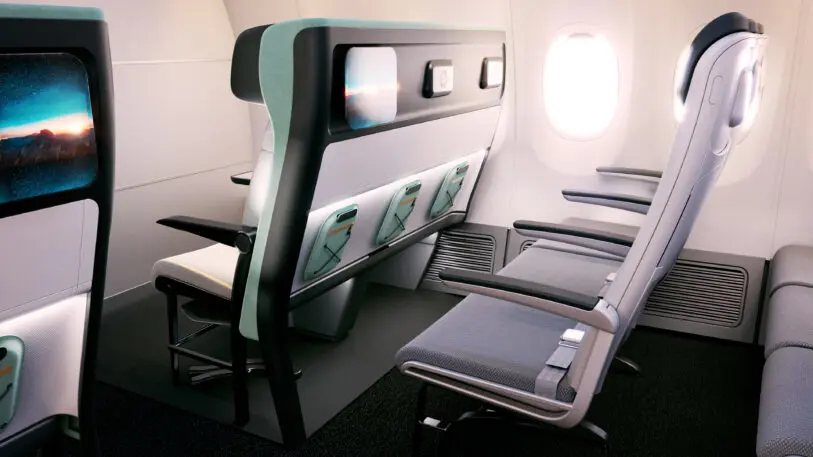In 1986, Congress passed the Air Carriers Access Act. It was a landmark piece of legislation that guaranteed air carriers couldn’t discriminate against people with disabilities. It’s why airlines can’t limit the number of disabled passengers on a flight, and why aircraft are designed with armrests that go up and down.
But have you ever seen someone sitting in a wheelchair on an airplane? You probably haven’t, because for the most part, personal wheelchairs aren’t actually allowed in the plane cabin. And that creates all sorts of problems for people who need their chair simply to sit safely.
A new project called Air 4 All could make flying with a wheelchair almost as easy as traveling without one. Designed by PriestmanGoode—a firm that has created airplane interiors for companies including Airbus, United, and Lufthansa—in conjunction with the airline regulatory partner SWS Certification and the consultant Flying Disabled, Air 4 All is a patented system that could allow any wheelchair to lock right onto a plane where a seat might otherwise go.

The problem
If you are a traveler with a disability, you can wheel up to the plane in your own chair before most people board. Then an airline agent lifts you out of your chair, placing you into a special, slim aisle wheelchair to be rolled to your seat. “It’s designed for the aircraft, not the person sitting in it,” says Chris Wood, founder of Flying Disabled.
The agents are not trained occupational therapists who understand how the human body can move. They’re just airline employees. And once you reach your seat, they lift, prod, or shove you to get into it.
It can be a physically invasive or even painful experience. “I know someone [who was] dropped on an aircraft floor who has spent six months in an airline hospital,” Wood says. What’s worse: Airline seats don’t work for many people who need wheelchairs. Power wheelchairs, in particular, don’t just wheel you forward without straining your arms. They are often devices customized to a single body, providing thoracic support, ensuring someone is able to sit safely upright rather than slump. Being strapped into an airline seat can actually be dangerous for some people.
As for what happens to your wheelchair once you’ve taken your seat? In limited cases, a folding wheelchair can stay in the cabin. Usually, it’s strapped onto a pallet and stored in cargo. Your chair, which requires a prescription and might be the price of a car, sits with luggage.

A better way
Air travel in a wheelchair is a perfect example of how policy alone isn’t enough to ensure equity. We also need to implement thoughtful design that considers the human experience.
Air 4 All bridges this gap between policy and UX. It’s made of two parts: One is a track installed on the floor of the plane. The other is a bracket installed onto a wheelchair.
As PriestmanGoode demonstrates in its proposal, the Air 4 All track can slip right under a folding seat in the front row of a plane. It allows someone to drive any wheelchair right in to lock in place. The user experience looks similar to the track systems used by car washes, which safely guide your wheel in before allowing the machine to take control of your vehicle. Safety-wise, the system is similar to the LATCH standard, which anchors baby seats securely in vehicles, even during high-speed impacts.
A corresponding bracket is affixed to the bottom of the wheelchair (a wheelchair can be retrofitted for this task). Generally, that bracket can be tucked out of the way, folding down only for air travel. Some of this work was done in conjunction with Sunrise Medical, a major wheelchair manufacturer.
The overall Air 4 All design is not only good for users. It’s also good for airlines, which can get by with fewer agents helping move people in wheelchairs—all without doing anything to reduce their typical seat footprint or ticket sales for able-bodied passengers.
“The Air 4 All system allows many different seat designs as the wheelchair and aircraft fixing bracket does not interact with the seat itself,” explains Paul Priestman, designer and chairman of PriestmanGoode. “This allows different airlines to design their own Air 4 All seat to meet their own unique service and brand requirements.”
What’s next? PriestmanGoode plans to debut a working prototype by the end of the year. Meanwhile, the designers need airlines to show interest in the project. For now, the Air 4 All team is in discussions with one anonymous carrier.
Wood hopes to see airlines step forward publicly and commit to integrating the design, noting, “We must not lose sight of the human being we’re trying to help here.”
Recognize your brand’s excellence by applying to this year’s Brands That Matter Awards before the early-rate deadline, May 3.